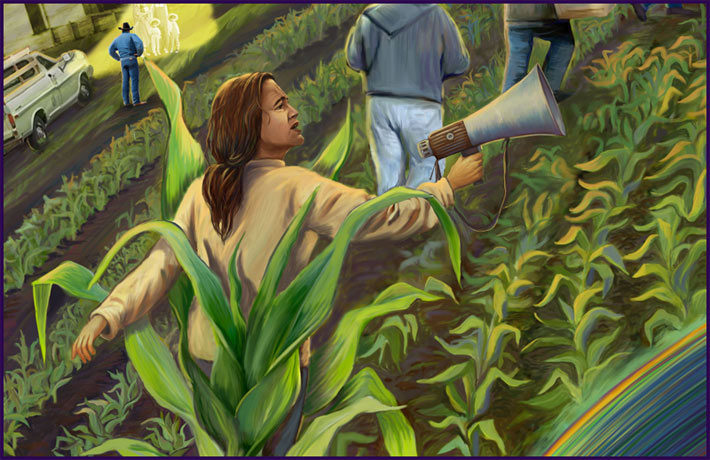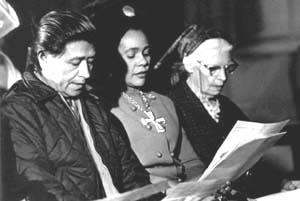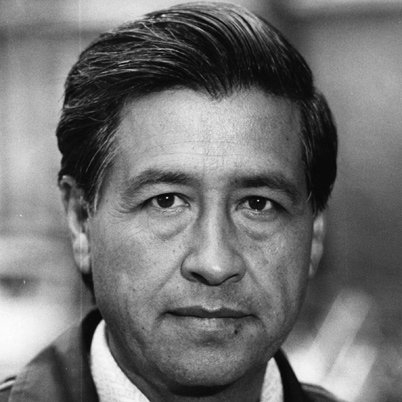We Are Un-American, We Are Catholics: Against the Draft
by Dorothy Day
Editor’s Preface: Dorothy, of course, wrote innumerable anti-war articles for The Catholic Worker. So why choose this one to accompany the Gandhi Center in Berlin’s “Manifesto against Conscription and the Military System”, also posted today? Of all of Dorothy’s pacifist articles, reportage, statements of principle, this article is filled with a certain righteous anger that she did not often allow to seethe through her other CW writings, a righteous indignation that intensifies the moral purpose and message. JG
Is it Soviet Russia who is the threat to the world? Is it indeed? Then may we quote from Scott Nearing’s The Way of the Transgressor? (1) “What nation today has a navy bigger than all other navies combined? The USA. What nation today is steadily adding to the only known stockpile of atom bombs? The USA. What nation today is tops in the development of buzz bombs, jet planes, bacterial poisons and death rays? The USA. What nation today is spending the largest sums on military preparations? The USA. What nation today is permitting representatives of the armed forces to take over the direction of domestic and foreign policy? The USA. What nation today is arming its neighbors (in Latin America), intervening in the internal affairs of Europe and Asia, threatening the world peace and security and rapidly surrounding itself with a black curtain of anxiety, suspicion and hatred? The USA.”
Dan Berrigan in Rochester
by Dorothy Day
Editor’s Preface: During the Vietnam War there was a debate within the pacifist and nonviolent movements about tactics, brilliantly discussed in a recent book by Shawn Francis Peters on the Catonsville Nine. [1] The Nine had made their own napalm to destroy draft files and this, and a previous protest by the Berrigans, set off a string of similar actions in which burning, pouring of blood, and various other “symbolic” means were used to destroy files. As Peters book points out Dorothy was at first hesitant about criticizing the tactic, but as the debate spread through the pacifist and nonviolent movements, despite or because of her friendship with both Phil and Dan Berrigan she took a firm nonviolent stand against the destruction of property not one’s own, which follows here. JG

Poster for showing of a film; Univ. of Kansas at Lawrence; artist unknown
Crying out in behalf of the jail population of this country which is by and large made up of blacks, Puerto Ricans, Mexicans, poor black and poor whites, in other words the poorest of the poor, Fr. Dan Berrigan has been heard from during this last month when he was called as a witness for one of the Rochester group, who are the latest to destroy draft files in government offices. [2] This group is one of the first to refuse lawyers (who must be paid sooner or later) except for one defendant who engaged only one – we presume, in order to call as character witness Fr. Berrigan from his prison cell in Danbury, Connecticut, where he is serving a long sentence with his brother Phil Berrigan, Josephite Father (dedicated to work among the blacks).
Fr. Berrigan was brought in chains to this upper New York State city where he was a character witness for Joe Gilchrist, one of the group. For some reason it took three days to transport him from Connecticut to New York State! He complained of the brutal and inhuman treatment he had received in transit. He testified also for all the prison poor in his protest.
The other defendants are remarkable in a number of ways. Two of them, Suzie Williams and DeCourcy Squires, refused bail and spent their time in prison awaiting trial. The others all showed up, not jumping bail and failing to appear as did some of those who have taken part in these actions of destruction of property.
Strike Leader Dolores Huerta
by Dorothy Day

Dolores Huerta c. 1969 rallying boycott support; detail of mural by Miguel Contreras at UCLA
Dolores Huerta is one of the heroines of the by now famous grape strike which began in Delano, California, in September 1965 and which is still going on [January 1969] in the form of a boycott, from one crisis to another. (1) There are many leaders of the farm workers all over the country, and I wish I could interview them all, in California, in Texas, in New Mexico, in the thirty cities of the United States where the weapon of the boycott is being used.
Cesar Chavez, head of the union, has been ill for some time and had to withdraw from active participation. He has been given worldwide recognition, and I would place him with the late Martin Luther King, Jr., and with Danilo Dolci and Vinoba Bhave, as an outstanding example of a nonviolent leader. We like to write about individuals in these movements for social justice, because, in a way, they are the word made flesh. We talk about what ought to be done, and here are the people doing it, putting flesh on the dry bones of principles and ideals. There must be the idea, the theory of the personalist and communitarian revolution, but the idea must be clothed with flesh and blood.
Dolores Huerta, who came from Delano, is a young, strong, and beautiful woman, mother of seven children, and the leader of the grape boycott in the Manhattan area. A big job. A year ago five or six pickets began the work, going from store to store, up and down the streets of Manhattan, to the big Hunts Point Market, to the chain stores, to the boats that were bringing grapes from the West Coast, telling of the injustices done the farm workers, the conditions under which they had to live, their struggles for better housing, wages and hours, and demanding that they be included with other workers under the National Labor Relations Act, from the benefits of which they have been excluded from the time the law first went into effect. Our friends, Filipino and Mexican picketers, who shared our poverty in a flat on Kenmare Street last year, went back to their families in Delano for Christmas in 1967 and returned with a score or more of other workers, driving in a donated unheated bus to begin their Northeastern campaign in earnest. It is this group that Dolores leads.
Cesar Chavez: Farmworkers Step Up Boycott
by Dorothy Day

Chavez, Coretta King & Dorothy; February 1973; photographer unknown
EDITOR’S PREFACE: Dorothy Day was a prolific writer and so a note of explanation about our choice of articles seems in order. Not only did Dorothy write her monthly column “On Pilgrimage” for The Catholic Worker, but she was an inveterate diarist and letter writer, contributor of articles to other publications, novelist and author of autobiographical writings, speeches, et al. By posting these three essays on Cesar Chavez, and other articles that will follow, we hope to remind readers of the central role Dorothy and The Worker played in the contemporary nonviolent movement. Often tagged anarcho-pacifist, The Catholic Worker newspaper was also at the center of the Gandhian nonviolence movement, as we have previously demonstrated in postings about Danilo Dolci and nonviolence in Sicily. In this essay Dorothy mentions that she was asked to share a pulpit with Coretta Scott King and Cesar Chavez, two of the leading members of the US nonviolent movement. This was neither deferential nor accidental. JG
It was a thrilling sight last month [February, 1973] to stand on the steps of the Cathedral of St. John the Divine and to see the parade of the United Farm Workers coming up the steps, all those beautiful, dark, sturdy men, women, and children, dressed in those clothes in which they work in the fields, flags flying with the Mexican Indian eagle black against the red of their banners, led by Cesar Chavez and Mrs. Martin Luther King. I had been invited too, but I could not take that long trek from the Riverside Drive Council of Churches headquarters, thru the Columbia University campus, and down to 110th Street where the Cathedral stands, magnificent in its stately grounds, on a height looking East over the City of New York.
I had enjoyed every minute of the evening before, and a fiesta held in the hall of the great old Paulist Church, surely one of the biggest in the city, where Marcos Munos (who heads the N.Y. office of the United Farm Workers) had prepared a party to greet the busload and caravan of ten cars which had made its zig-zag way across country from California. It was a pilgrimage to encourage the workers in various cities to continue the boycott of iceberg lettuce.
The Organizer Cesar Chavez
by Dorothy Day

Cesar Chavez, c. 1965; photographer unknown
“Workers of the World, unite. You have nothing to lose but your chains!” This is one of those stirring slogans of the Marxists especially appealing to youth, no matter what kind of family they come from, upper, middle, or lower middle class. If it does not attract them to Marxism, it at least gives them a sense of community and relatedness to other sufferers and combats the sense of futility and frustration, which encompasses so many.
Cesar Chavez is the leader of the Delano California farm-workers who are on strike in an area which stretches for 400 miles and includes thousands of acres of grapes, tomatoes, apricots, cotton — all kinds of crops. This strike, which has been going on since last September, appeals to all the poor of the United States. Chavez uses the word commitment, a word much in style now. But he combines it with the idea of necessity, the irrevocable. “We are committed,” he says. “When you lose your car, then lose your home, you do not become less committed, but more. None of us has anything more to lose.”
The agricultural workers of this country have long been the most abandoned and forgotten. They have been neglected in all Social Security legislation. From the first issue of The Catholic Worker, down through the years, we have written about the Negroes working on the levees, about the dispossessed sharecroppers of Arkansas and Oklahoma, the Mexicans in the onion fields of Ohio and Michigan, in sugar beets in the middle Northwest, about those who work in the potato farms in Maine, Long Island and New Jersey, in the turpentine woods of the South, about the citrus pickers of Florida, the Delta Negroes now being dispossessed from the cotton fields, and now the present strikers in California. The Catholic Worker has dealt with these stories and I have personally visited these fields of struggle.
Danilo Dolci’s Sicily
by Dorothy Day

Dorothy & Dolci, 1968; photographer unknown; courtesy Swarthmore College Peace Center.
While I was in Rome I assisted at a dialogue Mass at the Jesuit headquarters on the Via Santo Spiritu in Rome just down the street from the Hospital of the Holy Spirit, where one can still see the turnstile into which destitute mothers used to place their newborn infants to be succored by the nuns. After the kiss of peace and communion we went out into the cobbled streets to find a place to have dinner – Eileen Egan, Dorothy Coddington, Gary McEoin, Tom Cornell, Fabrizio Fabbrini and I. The only trouble with such an interesting group was that there were too many things to talk about, too many avenues to be explored.
Fabbrini, a professor at the university in Rome, had lost his position and had been imprisoned for six months in a damp cold cell beneath the level of the street. He was in the same cell with nine others, not conscientious objectors but sentenced on various charges. There was neither work nor exercise nor recreation for him, and one wonders how he stood it.
Gary could have told me something about Vatican finances, since he has written a book on the subject, but Dorothy Coddington began talking about the work of Danilo Dolci, and her talk was so interesting that I resolved to visit Sicily before proceeding to London. Eileen was going on to Isreal and had already been to Trieste.
A Meeting with Ignazio Silone
by Dorothy Day

Ignazio Silone; photographer unknown.
In wrestling with the problem of how to present the teachings of nonviolence in an age of mass violence, it seems to me that the writings of Ignazio Silone are of immense importance. When I first read Bread and Wine in the forties, I was deeply impressed, not only with the story of the revolutionary returning secretly from his exile in Switzerland, but with the call to a personalist approach which must precede any communitarian effort.
I had heard from Father Jack English, a former CW editor, of Silone’s visit to the Trappist monastery of the Holy Spirit at Conyers, Georgia. Silone spent the day at the Abbey within the enclosure, and it was left to Father English to be guest master and converse with his wife, a beautiful Irish woman whom he met during his exile in Switzerland. They had come to Atlanta to discuss the problems of the South and had been brought to the monastery by the editor of the Atlanta Constitution because there was an international meeting of the Trappist order going on there.
On another occasion Silone and his wife had visited New York and New England and had called the office of The Catholic Worker, but I did not receive the message until they were well on their way back to Italy.
So I was delighted when I was invited to dine with them in Rome in late October. We went to a restaurant on the Piazza Carlo Goldoni that was usually very quiet, they said. There was a large area outside for dining; but it was a cool night, so we went into one of the small rooms, which, unfortunately, was very crowded and noisy that night. There were two tables full of noisy young Americans, one large party of uproarious Italians and still another family with small babies. So I did not get as complete an interview as I would have liked.




